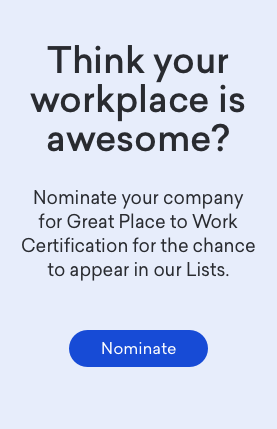The Fairness Factor
Have you seen who made this year's 50 Best Small & Medium Workplaces List? The 12th annual list, announced last week, features organizations that are 25 to 999 employees in size and demonstrate exceptional workplace cultures. They are, in essence, the crème de la crème of human-centered workplaces of their size, and their rapid growth is just another reminder that high-trust cultures bring a competitive business advantage.
A valuable trait that small organizations have over large ones is that by virtue of their size it's easier to build and foster trust (think more transparency, a tighter-knit community, less separation between hierarchical levels, etc.). And since trust is the defining component of great workplaces, this advantage is noteworthy. We can see it playing out in this year's list, as there are key differences between the 2015 100 Best Companies to Work For® (1000+ employees) and the 2015 50 Best Small & Medium Workplaces in the Trust Index© Employee Survey statements that we use to determine list. Most notably, employees at smaller companies are more likely to believe theirs is a fair workplace.
When comparing this year's 100 Best Companies to Work For® with the 50 Best Small & Medium Workplaces, among the largest gaps in score that favor small and medium companies are for the statements:
- Promotions go to those who best deserve them (an average 87% of employees across Small & Medium Workplaces believe this is true at their company, versus 75% at the 100 Best)
- People avoid politicking and backstabbing as ways to get things done (89% SMW vs. 78% 100 Best)
- Managers avoid playing favorites (83% SMW vs. 73% 100 Best)
- I receive a fair share of the profits made by this organization. (83% SMW vs. 73% 100 Best)
As described in the Great Place to Work® Trust Model©, Fairness is a key component of trust, and is composed several components:
- Equity (fair pay and profit sharing; equal opportunities; fair treatment across job roles)
- Impartiality (fair promotions; lack of favoritism)
- Justice (fair treatment regardless of personal characteristics; feeling one has the right to challenge unfair decisions).
At its heart, fairness addresses whether employees believe they are operating on a level playing field.
The difficult part about perceptions of fair treatment is that they are usually just that: perceptions. And not just any perceptions, but ones that are attached to deeply rooted feelings of self-worth within the human psyche. Even at the very best workplaces, the survey statements measuring Fairness tend to have the lowest results.
As an example, perceptions of favoritism are very difficult to manage. It is impossible for managers to make every interaction with employees equal at all times. Couple this with the fact that management decisions around promotions and other personnel issues cannot always be transparent, and it becomes easy for perception to become reality – and for the experience of fairness to plummet.
It's clear from our survey results that the Best Small & Medium Workplaces are able to foster a strong sense of fairness despite these challenges. After all, it's worth the effort: there's nothing more demoralizing than a sense of injustice at work. So, how do they do it? Through programs and practices that strive to promote:
- Fair Profit Sharing:
Example: Best Company Centro employs a progressive compensation policy and a special team dedicated to Total Rewards, specifically to compensation. They look at every single every job, every year, and use compensation data from acclaimed compensation surveys in their niche industry to ensure fair pay. Fairness is not based on subjectivity, what projects employees have worked on, or how long they have been at the company, but based on the market data and what each individual's marketability is within a certain range. - Fairness in Promotions/Employee Development:
Example: This year Best Company Insomniac Games created the "Career Path Matrix", which builds on an established career path document to help employees understand the requirements of each position or ladder in their career. The Career Path Matrix is an entire grid for each job family that not only provides basic responsibilities and educational criteria but outlines the key differentiating factors necessary to take the next step in a career path. This enables employees to work with their manager and with a career coach in HR to define a goal plan/path to promotion that is clear, measurable and attainable. - Transparency in Communication:
Example: After results from last year's engagement survey at Best Company American Transmission Co. identified the need for further clarification about compensation and rewards, their leadership team conducted focus groups to identify what employees did not understand about the process, giving employees a voice in the solution. Sixty employees in different roles were selected for the focus groups and a task force of supervisors was formed to review the programs and establish a plan going forward. Feedback from the focus groups was used inform training sessions about compensation and performance, and evaluate ATC's rewards and recognition programs.
Along with the other two pillars of trust: Leadership Credibility and Respect for Employees, these sorts of practices that promote a sense of fairness help to combat perceptions of favoritism and the need to politick. Most importantly, they generate a positive overall experience of the workplace among all employees. And at the end of the day, that's what matters the most.
Check out more great practices by reading the company bios from the 2015 50 Best Small & Medium Workplaces List.














